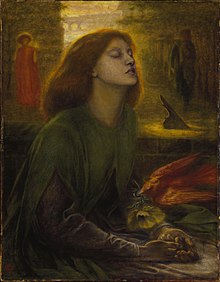Florentine beauty was immortalised in verse
Beatrice ‘Bice’ di Folco Portinari, who has been identified as the lifelong love of the important poet Dante Alighieri, died on this day in 1290 in Florence, at the age of 25.
Dante Gabriel Rosetti's idealised
19th century portrait of Beatrice
Dante is believed to have met Beatrice only twice, but was said to have been so affected by the encounters that he loved her for the rest of his life.
Many scholars believe Beatrice was the inspiration for Dante’s work, Vita Nuova, and that she also acted as his guide in the last book of his narrative poem, the Divine Comedy, and was the symbol of divine grace and theology in his poetry.
Beatrice was the daughter of a rich banker, Folco Portinari, and she lived in a house near Dante’s home in Florence. Dante first met Beatrice when they were both just nine years old at a May Day party given by her family.
But by the time Dante was 12, he had been promised by his parents in marriage to Gemma di Manetto Donati, who was from another powerful, local family.
Years after his marriage to Gemma, Dante claimed he met Beatrice again and he wrote several sonnets to her, without ever getting to know her properly, which were examples of the mediaeval notion of courtly love.
Beatrice was married to another banker, Simone dei Bardi. There is very little information about her life apart from the mention of a bequest to her in the will of her father, Folco, which was dated 1287.
 |
| Henry Holiday's 1883 painting imagines Dante gazing at Beatrice (centre, in cream) |
Dante and his wife, Gemma, had three children after Beatrice died and one of them was named Beatrice.
Beatrice Portinari has also been immortalised in paintings by pre-Raphaelite artists in the 19th century. Dante Gabriel Rosetti idealised her image in his painting, Beata Beatrix, which was completed after the death of his own wife, Elizabeth Siddal.
Asteroid 83 Beatrix in the asteroid belts is named after Dante’s heroine, in recognition of her role as Dante’s guide through the heavenly spheres.
The Dante Alighieri Academy Beatrice Campus, a Catholic high school in Toronto in Canada, also takes its name from the story of Dante and Beatrice.
Travel tip:
Museo Casa di Dante has exhibits that
illustrate the poet's life and works
Dante’s passion for Beatrice was captured in a painting by Henry Holiday in 1883. The artist depicts the poet looking longingly at her as she walks at the side of the River Arno in Florence with a friend. Dante’s home, which is now Museo Casa di Dante, a museum dedicated to his life, is in Via Santa Margherita, close to the River Arno. The museum is open daily from 10 am till six pm in summer and from Tuesday to Sunday from 10 am till five pm between October and March. The museum is spread over three floors with exhibits illustrating the life and works of the great poet.
Travel tip:_-_Facade.jpg)
Dante's tomb at San Pier
Maggiore church in Ravenna
Museo Casa di Dante is close to Florence’s famous Basilica di Santa Croce, where an empty tomb still waits for the poet’s remains. After being exiled from Florence by a rival group of Guelphs, Dante accepted an invitation from Prince Guido Novello da Polenta to go to Ravenna in 1318. He finished Paradiso - the final part of the Divine Comedy - and died there, possibly of malaria, at about the age of 56. Dante was buried at the Church of San Pier Maggiore and a tomb was erected for him there in 1483. Florence made repeated requests for the return of Dante’s remains, but the city of Ravenna has always refused to relinquish them.
Also on this day:
1671: The birth of composer Tomaso Albinoni
1699: The birth of architect Benedetto Alfieri
1823: The birth of archaeologist Giuseppe Fiorelli
1852: The birth of physician Guido Banti
1916: The birth of film director Luigi Comencini
Recommended reading:
No comments:
Post a Comment